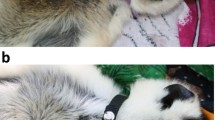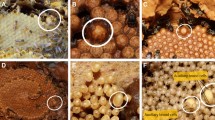Abstract
Remarkably little is known about the traits that determine reproductive success of males in eusocial insects. Their window for mate choice decisions is very short, the actual mating process is very difficult to observe, and their small body sizes have likely prevented systematic studies in many species. In 2008 and 2009, we revisited a Panamanian population of Atta colombica leafcutter ants to partially repeat and complement a study of more than 15 years ago. We compared within- and between-colony variation in male body size (mass and width of head, mesosoma and gaster) and sperm characteristics (length, number and survival after exposure to saline buffer with and without added accessory gland secretion). We also measured the size of accessory glands as the main contributor of seminal fluid and the accessory testes containing all mature sperm, but we found few correlations between these variables. We also obtained little or no evidence for expected trade-offs between sperm number and sperm length and between mesosoma mass and sperm complement, although this could be due to limited sample size and unknown variation in larval resource allocation that was beyond our control. However, we found an interestingly bimodal distribution in broad-sense heritabilities (intra-class correlations) among the variables that we measured. Low heritabilities suggest that mesosoma size (mass and width), accessory testes size, sperm viability (measured as % survival in saline) and probably also accessory gland size are traits directly correlated with reproductive success. However, the much higher heritabilities for total body mass, gaster mass, head width, sperm length and sperm number suggest that these traits are less likely to make direct contributions to male fitness.



Similar content being viewed by others
References
Baer B. 2003. Bumblebees as model organisms to study male sexual selection in social insects. Behav. Ecol. Sociobiol. 54: 521-533
Baer B. 2005. Sexual selection in Apis bees. Apidologie 36: 187-200
Baer B. 2010. The copulation biology of ants (Hymenoptera: Formicidae). Myrmecol. News 14: 55-68
Baer B., Armitage S.A.O. and Boomsma J.J. 2006. Sperm storage induces an immunity cost in ants. Nature 441: 872-875
Baer B. and Boomsma J.J. 2004. Male reproductive investment and queen mating-frequency in fungus-growing ants. Behav. Ecol. 15: 426-432
Baer B., de Jong G., Schmid-Hempel R., Schmid-Hempel P., Hoeg J.T. and Boomsma J.J. 2006. Heritability of sperm length in the bumblebee Bombus terrestris. Genetica 127: 11-23
Baer B., Dijkstra M.B., Mueller U.G., Nash D.R. and Boomsma J.J. 2009. Sperm length evolution in the fungus-growing ants. Behav. Ecol. 20: 38-45
Birkhead T.R., Fletcher F., Pellatt E.J. and Staples A. 1995. Ejaculate quality and the success of extra-pair copulations in the zebra finch. Nature 377: 422-423
Boomsma J.J., Baer B. and Heinze J. 2005. The evolution of male traits in social insects. Annu. Rev. Entomol. 50: 395-420
Chown S.L. and Gaston K.J. 2010. Body size variation in insects: a macroecological perspective. Biol. Rev. 85: 139-169
Couvillon M.J., Hughes W.O.H., Perez-Sato J.A., Martin S.J., Roy G.G.F. and Ratnieks F.L.W. 2010. Sexual selection in honey bees: colony variation and the importance of size in male mating success. Behav. Ecol. 21: 520-525
Cremer S., Ugelvig L.V., Drijfhout F.P., Schlick-Steiner B.C., Steiner F.M., Seifert B., Hughes D.P., Schulz A., Petersen K.S., Konrad H., Stauffer C., Kiran K., Espadaler X., d’Ettorre P., Aktac N., Eilenberg J., Jones G.R., Nash D.R., Pedersen J.S. and Boomsma J.J. 2008. The evolution of invasiveness in garden ants. PLoS One 3: e3838
Den Boer S.P.A., Baer B. and Boomsma J.J. 2010. Seminal fluid mediates ejaculate competition in social insects. Science 327: 1506-1509
Den Boer S.P.A., Baer B., Dreier S., Aron S., Nash D.R. and Boomsma J.J. 2009. Prudent sperm use by leaf-cutter ant queens. Proc. R. Soc. B. 276: 3945-3953
Den Boer S.P.A., Boomsma J.J. and Baer B. 2008. Seminal fluid enhances sperm viability in the leafcutter ant Atta colombica. Behav. Ecol. Sociobiol. 62: 1843-1849
Den Boer S.P.A., Boomsma J.J. and Baer B. 2009. Honey bee males and queens use glandular secretions to enhance sperm viability before and after storage. J. Insect Physiol. 55: 538-543
Falconer D.S. 1981. Introduction to Quantitative Genetics. Longmans Green London
Fjerdingstad E.J. 2005. Control of body size of Lasius niger ant sexuals - worker interests, genes and environment. Mol. Ecol. 14: 3123-3132
Fjerdingstad E.J. and Boomsma J.J. 1997. Variation in size and sperm content of sexuals in the leafcutter ant Atta colombica. Insect. Soc. 44: 209-218
Gage M.J.G. 1991. Risk of sperm competition directly affects ejaculate size in the mediterranean fruit-fly. Anim. Behav. 42: 1036-1037
Gage M.J.G. 1994. Associations between body-size, mating pattern, testis size and sperm lengths across butterflies. Proc. R. Soc. Lond. Ser. B-Biol. Sci. 258: 247-254
Heinze J. and Hölldobler B. 1993. Fighting for a harem of queens - physiology of reproduction in Cardiocondyla male ants. Proc. Natl. Acad. Sci. USA. 90: 8412-8414
Heinze J. and Schrempf A. 2008. Aging and reproduction in social insects - A mini-review. Gerontology 54: 160-167
Holman L. 2009. Drosophila melanogaster seminal fluid can protect the sperm of other males. Funct. Ecol. 23: 180-186
Hughes W.O.H., Oldroyd B.P., Beekman M. and Ratnieks F.L.W. 2008. Ancestral monogamy shows kin selection is key to the evolution of eusociality. Science. 320: 1213-1216
Hughes W.O.H., Sumner S., Van Borm S. and Boomsma J.J. 2003. Worker caste polymorphism has a genetic basis in Acromyrmex leaf-cutting ants. Proc. Natl. Acad. Sci. USA. 100: 9394-9397
Hölldobler B. and Bartz S.H. 1985. Sociobiology of reproduction in ants. Progr. Zool. 31: 237-257
Hölldobler B. and Wilson E.O. 1990. The Ants. The Belknap Press of Harvard University Press Cambridge Massachusetts. 732 pp
Kronauer D.J.C., Johnson R.A. and Boomsma J.J. 2007. The evolution of multiple mating in army ants. Evolution 61: 413-422
Moore P.J., Harris W.E., Montrose V.T., Levin D. and Moore A.J. 2004. Constraints on evolution and postcopulatory sexual selection: trade-offs among ejaculate characteristics. Evolution 58: 1773-1780
Peeters C. and Ito F. 2001. Colony dispersal and the evolution of queen morphology in social Hymenoptera. Annu. Rev. Entomol. 46: 601-630
Peeters C.P. 1991. Ergatoid queens and intercastes in ants - Two distinct adult forms which look morphologically intermediate between workers and winged queens. Insect. Soc. 38: 1-15
Schlüns H., Schlüns E.A., van Praagh J. and Moritz R.F.A. 2003. Sperm numbers in drone honeybees (Apis mellifera) depend on body size. Apidologie. 34: 577-584
Simmons L.W. and Kotiaho J.S. 2002. Evolution of ejaculates: Patterns of phenotypic and genotypic variation and condition dependence in sperm competition traits. Evolution 56: 1622-1631
Smith C.R., Anderson K.E., Tillberg C.V., Gadau J. and Suarez A.V. 2008. Caste determination in a polymorphic social insect: Nutritional, social, and genetic factors. Am. Nat. 172: 497-507
Stearns S.C. 1992. The Evolution of Life Histories. Oxford University Press Oxford, New York. 248 pp
Van Noordwijk A.J. and De Jong G. 1986. Acquisition and allocation of resources: their influence on variation in life history tactics. Am. Nat. 128: 137-142
Villesen P., Murakami T., Schultz T.R. and Boomsma J.J. 2002. Identifying the transition between single and multiple mating of queens in fungus-growing ants. Proc. R. Soc. Lond. Ser. B-Biol. Sci. 269: 1541-1548
Acknowledgments
We thank the Smithsonian Tropical Research Institute (STRI) in Panama for facilities and logistic support and the Autoridad Nacional de Ambiente (ANAM) for issuing collecting permits. This work was supported by grants from the Danish National Research Foundation to JJB and DRN and an Australian Research Council Queen Elizabeth II fellowship to BB.
Author information
Authors and Affiliations
Corresponding author
Rights and permissions
About this article
Cite this article
Stürup, M., den Boer, S.P.A., Nash, D.R. et al. Variation in male body size and reproductive allocation in the leafcutter ant Atta colombica: estimating variance components and possible trade-offs. Insect. Soc. 58, 47–55 (2011). https://doi.org/10.1007/s00040-010-0115-0
Received:
Revised:
Accepted:
Published:
Issue Date:
DOI: https://doi.org/10.1007/s00040-010-0115-0




